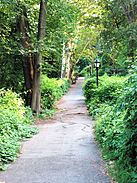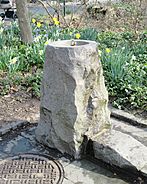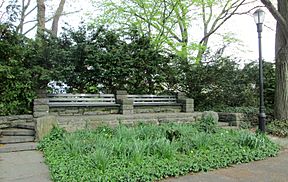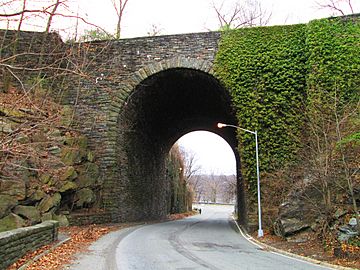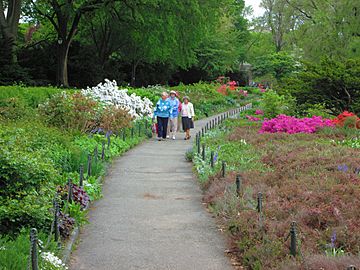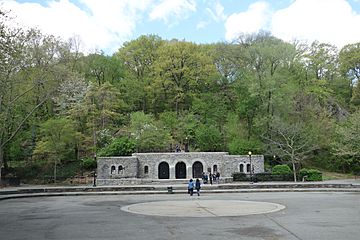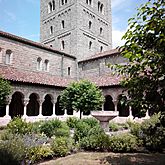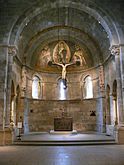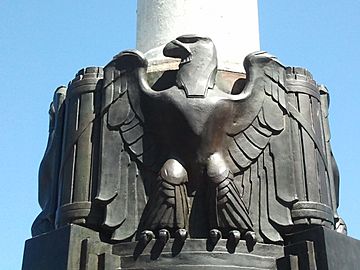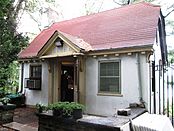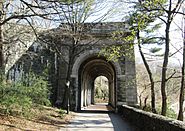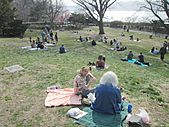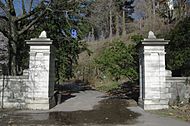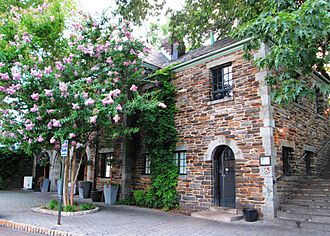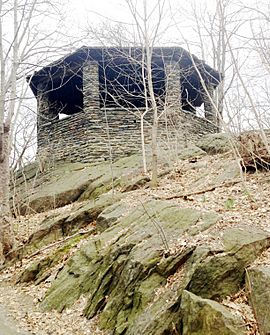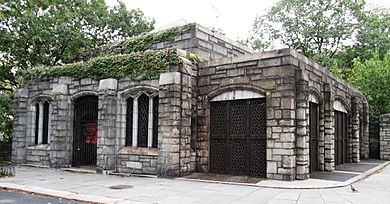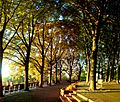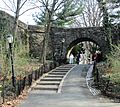Fort Tryon Park facts for kids
Quick facts for kids Fort Tryon Park |
|
|---|---|
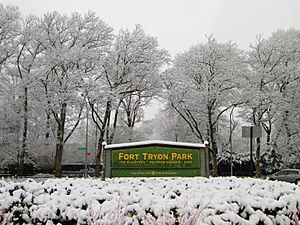
(2013)
|
|
| Location | Hudson Heights/Inwood, Manhattan, New York |
| Area | 67.21 acres (27 ha) |
| Elevation | 268 feet (82 m) |
| Created | 1935 |
| Designer | Olmsted Brothers |
| Etymology | Sir William Tryon |
| Operated by | NYC Parks |
| Open | 6 a.m. to 1 a.m. |
| Status | Open all year |
| Public transit access | Subway: Bus: M4, M98, M100, Bx7 |
|
Fort Tryon Park and the Cloisters
|
|
| Location | bounded by 190th Street, Cabrini Boulevard, 192nd Street, Bennett Avenue, Broadway, Riverside Drive, and Henry Hudson Parkway Manhattan, New York City |
| Area | 66.5 acres (26.9 ha) |
| Built | 1935 |
| Architect | Olmsted Brothers: (Frederick Law Olmsted, Jr., James W. Dawson) |
| Architectural style | Romanesque |
| NRHP reference No. | 78001870 |
| Significant dates | |
| Added to NRHP | December 19, 1978 |
Fort Tryon Park is a public park located in the Hudson Heights and Inwood neighborhoods of the borough of Manhattan in New York City. The 67-acre (27 ha) park is situated on a ridge in Upper Manhattan, close to the Hudson River to the west. It extends mostly from 192nd Street in the south to Riverside Drive in the north, and from Broadway in the east to the Henry Hudson Parkway in the west. The main entrance to the park is at Margaret Corbin Circle, at the intersection of Fort Washington Avenue and Cabrini Boulevard.
The area was known by the local Lenape tribe as Chquaesgeck and by Dutch settlers as Lange Bergh (Long Hill). During the American Revolutionary War, the Battle of Fort Washington was fought at the site of the park. The area remained sparsely populated during the 19th century, but by the turn of the 20th century, it was the location of large country estates. Beginning in 1917, philanthropist John D. Rockefeller, Jr., bought up several of the estates to create Fort Tryon Park. He engaged the Olmsted Brothers firm to design the park and hired James W. Dawson to create the planting plan. Rockefeller gave the land to the city in 1931, after two prior attempts to do so were unsuccessful, and the park was completed in 1935. Rockefeller also bought sculptor George Gray Barnard's collection of medieval art and gave it to the Metropolitan Museum of Art, which from 1935 to 1939 built the Cloisters in Fort Tryon Park to house the collection.
The park is built on a high formation of Manhattan schist with igneous intrusions and glacial striations from the last Ice Age. The park's design included extensive plantings of various flora in the park's many gardens, including the Heather Garden, which was restored in the 1980s. Besides the gardens and the Cloisters, the park has extensive walking paths and meadows, with views of the Hudson and Harlem Rivers. Fort Tryon Park was added to the National Register of Historic Places in 1978 and was designated a New York City Scenic Landmark in 1983.
Contents
Geography and geology
Fort Tryon Park covers 67.21 acres (27.20 ha). It is bounded on the west by the Henry Hudson Parkway, on the north by Riverside Drive, on the east by Broadway and Bennett Avenue, and on the south by the alignment of 192nd Street. A small section at the park's southwestern corner is located between Cabrini Boulevard to the east and Henry Hudson Parkway to the west, and is bounded to the south by 190th Street. The park is adjacent to Inwood Hill Park to the north and Fort Washington Park and Riverside Park to the south; all are part of the Manhattan Waterfront Greenway. The park offers views of the Hudson River, the George Washington Bridge, and the New Jersey Palisades, to the west; Washington Heights to the south; Inwood and the Bronx to the north; and the Harlem River to the east. The north–south Henry Hudson Parkway and Amtrak's Empire Connection run alongside the western edge of the park.
The park is built on a formation of Manhattan schist and contains examples of igneous intrusions and of glacial striations from the last Ice Age. The lower lying regions to the east and north of the park are built on Inwood marble. Outcroppings of gneiss and schist can be seen interlaid with the marble, as seen in the outcroppings at the park's edges. Fort Tryon Park also contains a large glacial pothole.
The northern boundary of the park is formed by the seismologically active Dyckman Street Fault. The fault creates a valley separating Fort Tryon Park from Inwood Hill Park to the north. In precolonial times, a Native American road ran within this valley from the present-day intersection of Broadway and Dyckman Street to a settlement on the Hudson River. The valley formerly contained an inlet named Little Sand Bay, which flowed into the Hudson River to the west. As recently as 1989, activity of this fault caused a magnitude 2 earthquake.
Another valley separated Fort Washington from a hill to the east, which hosted Fort George. This valley contained a stream, which was known as the Hessian Spring. The stream emptied into Half Creek (later Sherman Creek), which in turn led to the Harlem River to the east.
Design
Olmsted Brothers created a plan that adapted the area's steep topography into a landscaped park. According to their original 1927 design, Fort Tryon Park was to be a "landscape park occupying a site of extraordinary landscape interest", devoted mostly to "passive recreation" except for a playground at its northern edge. Fort Tryon Park's landscape also served as the backdrop for the Cloisters, intended as the "culminating point of interest in the architectural design of the park." The natural topography was largely preserved, with the park being designed around the terrain. Olmsted Jr. believed that the park should use a variety of landscapes:
Each unit in this intricate series of places should offer a picture of as great perfection as can be contrived, using the same great distant views over the Hudson and over the City gain and again but framing them differently, presenting them with constantly differing types of foreground, some intricate and intimate, some grandiose and simple, some richly architectural or gardenesque, some picturesquely naturalistic; and, by way of contrast, some presenting wholly self-contained scenes.
In a continuation of his father's design philosophy, Olmsted Jr. included passive recreation features such as numerous tiers of paths; a combination of natural and manmade slopes; and the addition of plantings and rock forms to supplement existing features of the park site. The few small flat areas were converted to lawns with trees on their perimeters. Stone retaining walls were placed along slopes to prevent visitors on the paths from falling off the cliffs. The park also included curved drives and pathways for vehicles and pedestrians, as well as segregated vehicle and pedestrian uses. Other design features in Fort Tryon Park included the use of arches; segregation of passive and active recreational activities; the diversity and precise arrangement of plantings; the variety of different landscape designs; and the blend of naturalistic and architectural features. Similar design principles were also included in Morningside Park and in the Ramble at Central Park, both designed by Olmsted's father upon steep terrain.
In contrast to previous parks created by Olmsted Jr. and his father, Fort Tryon Park emphasized architecture and was more accommodating to vehicles. The park's retaining walls were more prominent than in previous parks, and the Cloisters was the most prominent feature of the park. Further, Fort Tryon Park contained parking lots and vehicle overlooks, in contrast to other parks that discouraged vehicle use. Other deviations from past designs included the emphasis of Heather Garden, a gardenesque feature, as well as the formally-designed children's playground at the northeast corner. The design includes numerous architectural features including Corbin Circle and Linden Terrace.
Circulation
Fort Tryon Park contains numerous roads that can accommodate light traffic volumes. The primary road, named Margaret Corbin Drive, carries traffic from the park's southern entrance at Corbin Circle to a roadway that loops around the Cloisters. Formally designated in 1977, the name commemorates the Continental Army soldier in the American Revolutionary War who was wounded in the Battle of Fort Washington. A secondary roadway named Fort Tryon Place carries traffic to and from the northbound lanes of Henry Hudson Parkway, at the bottom of the cliff to the west. Corbin Drive passes above Fort Tryon Place via a pair of masonry arches: one large arch at a rock cut that carries both directions of Corbin Drive above both directions of Fort Tryon Place, and a smaller arch that carries northbound Corbin Drive over the westbound Fort Tryon Place. The drive contains numerous small parking lots.
The north–south Fort Washington Avenue ends at Corbin Circle, though it once extended north through the park. Another street, Abbey Hill Road, once connected Margaret Corbin Drive with Broadway, though it no longer exists on maps. The north–south Overlook Terrace, on the south side of the park, was authorized to be extended to Corbin Circle, though that section was not built.
An 8-mile (13 km)-long network of pedestrian pathways is also located within the park. Along the edges of some paths, there are rows of stone that have been cut and placed to produce naturalistic effects. Tunnels carry the paths under the drives at two locations: at Fort Tryon Place and near the concession building. Another bridge carries a path over Fort Tryon Place. Ramps and stairways connect the park to Broadway and Riverside Drive, respectively located at the bottom of the cliff to the east and north. A formal promenade, containing seating areas and elm trees, runs north from Corbin Circle to Linden Terrace.
Plantings
The park site was originally planted with numerous trees, both native and imported. Olmsted Brothers transported 180 fully grown "mature trees" and planted more than 1,600 floral species to make the park appear like a botanical garden. The various sections of Fort Tryon Park were planted with herbaceous plants, shrubs, and trees representing different seasons. There were also numerous small lawns including the Children's Play Lawn and the Picnic Grounds, as well as formal planted areas such as Corbin Circle, the promenade, the terrace, and the playground. The Heather and Alpine Gardens were distinctly designed with a large variety of plantings. Though it is illegal to forage for plants inside Fort Tryon Park, or at any other public park within the city, relatively few summons are written for such violations within the park.
The Heather Garden, located in a ridge west of Corbin Drive and the promenade, is described by NYC Parks as "the largest public garden with unrestricted access in New York City", with an area of 3 acres (1.2 ha). It was planned by the Olmsted Brothers as a gardenesque site with American elm trees and low-growing heather, also known as Calluna vulgaris. The short height of the heather was intended to allow views of the Hudson River, and stone seating allowed visitors to observe the landscape. The heather took several years to grow to its full height. The Heather Garden became overgrown with invasive species after a remodeling in 1955 failed to take Olmsted's design into consideration. The garden was restored in the late 1980s following Olmsted's original plans. Minor additions and improvements continued to take place afterward. The garden contains perennials, shrubs, and trees, as well as plantings representing each season.
The Alpine Garden, the other formal space planned by the Olmsted Brothers, is located on the ridge along the park's eastern side, to the east of the Cloisters. It contains a stone stair and a grotto. Originally planted with alpine plants, the garden later became overgrown before being restored in 2009. The garden incorporates numerous rocks, which according to NYC Parks' website "compliment [sic] the outcroppings of metamorphic Manhattan schist". The rocks used in the garden include quartz, feldspar, mica, and garnet; some of the stone comes from excavations during the park's and subway's construction.
In addition, the Cabrini Woods Nature Sanctuary runs alongside Cabrini Boulevard at the southwestern corner of the park. The woods connect to Inwood Hill Park and Fort Washington Park, the last two natural woodlands in Manhattan. Both the woods and the boulevard are named after Frances Xavier Cabrini, the first American canonized as a Roman Catholic saint. The woods serve as a habitat for wildlife, including 80 bird species as well as possums, raccoons, and skunks.
Playgrounds
Fort Tryon Park contains two playgrounds. The park's northeast corner contains the Anne Loftus Playground, a triangle-shaped play area that primarily serves the Inwood neighborhood to the north. It is named after Anne Susan Cahill Loftus, a local resident who was the district manager of Manhattan Community Board 12 between 1980 and 1989. Opened in 1934, the playground was the only section of Fort Tryon Park that was originally intended for "active recreation" and the only playground designed by the Olmsted Brothers. The Olmsted Brothers built the playground on the site because of its flatness and proximity to the streets nearby. The southwest side of the Anne Loftus Playground contains a one-story stone fieldhouse with a rooftop observation deck that is set into the cliff, and the northeast side contains an entrance to the Dyckman Street station. A large wading pool is located in the middle of the playground, and plane trees encircle the play area. The playground was restored in 1995-1997 under a $1.44 million project that also added handicapped-accessible facilities, additional play structures, and performance space.
The other playground in Fort Tryon Park is the Jacob K. Javits Playground, which primarily serves Hudson Heights and is named after U.S. senator Jacob Javits. The play area contains a play structure and basketball courts, as well as elm trees throughout the playground. When the park was created, Empire Mortgage initially leased the playground to the city before giving away the land as a gift in 1944. The playground was transferred to NYC Parks in 1981 and renamed after Javits in 1984. It was renovated in 1995. After a second period of decline, another renovation of the playground started in 2019.
Other features
Margaret Corbin Circle is located at the intersection of Cabrini Boulevard and Fort Washington Avenue, on the park's southern border. Formerly known simply as the South Plaza, it was renamed in 1977 after Corbin. The plaza consists of a roundabout for traffic, and is surrounded by a low stone perimeter wall, with stone posts flanking the entrances to the building. A planted circle is located in the center of the roundabout. The old Fort Tryon Cottage (see § Billings estate) and the station building to the New York City Subway's 190th Street station are located on the edges of the plaza. A bronze plaque commemorating Corbin is located on the perimeter wall.
Sir William's Dog Run is located to the east of Corbin Drive, south of the overpass over Fort Tryon Drive. The dog run is open 24 hours a day and its regulations allow owners to take their dogs off-leash. Opened in 2001, it is described as the largest dog run in Manhattan. Several trees within Sir William's Dog Run are surrounded by short barriers to prevent damage to their roots.
Structures
Buildings in Fort Tryon Park include the Cloisters, the gatehouse, a cafeteria and administration building, the field house, and the subway fan house and shed. Except for the Cloisters, these buildings are mostly single-story masonry structures made with ashlar. Numerous other structures also exist, including a gazebo and the Billings Arcade.
The Cloisters
The Cloisters is a branch of the Metropolitan Museum of Art that houses the museum's extensive collection of medieval European art and artifacts, including the Unicorn Tapestries. The museum's buildings are a combination of medieval structures bought in Europe and reconstructed on-site stone-by-stone, and new buildings in the medieval style designed by Charles Collens. The Cloisters consists of four main cloister structures: Cuxa, Saint Guilhem, Bonnefont, and Trie. The Cloisters also contains three gardens, one each within the Cuxa, Bonnefont, and Trie cloisters. The museum is surrounded by the circular park drive, and its site is bounded by many plantings including an apple orchard to the south and denser vegetation to the north and west. A driveway and a bus stop with Belgian blocks is located at the northeastern portion of the site.
The museum was created after John D. Rockefeller Jr. purchased the medieval art collection of George Grey Barnard, and gave it to the Met along with his own collection. Rockefeller, retaining Bernard as an advisor, decided that Fort Tryon Park was the most suitable place for the collection. The Met then had the Cloisters built in Rockefeller's newly created Fort Tryon Park with endowment money from Rockefeller. The Cloisters opened to the public in 1938. A northern extension to the Cloisters, The Fuentidueña Apse, was completed in 1961.
Linden Terrace
The David Rockefeller Linden Terrace is located at the Promenade's northern end, on the site of Fort Tryon and Tryon Hall. The terrace is located 268 feet (82 m) above sea level, the highest location in Fort Tryon Park. It is also the highest landscape feature on Manhattan Island, as measured by the distance between ground level and sea level. However, Linden Terrace is not the island's highest natural point, which is located within Bennett Park a few blocks south, 265 feet (81 m) above sea level. Linden Terrace is supported with stone retaining walls of up to 40 feet (12 m) tall. It comprises a main observation deck and the smaller Northeast Terrace, which are linked by an arch across a passageway below. In the early 21st century the terrace was renamed after John D. Rockefeller Jr's last surviving child David, who had donated $1 million toward the park.
The main portion contains a terraced seating area with elms. There is plaque installed in 1935 that recognizes John Rockefeller Jr's donation of the parkland, as well as another plaque installed in 2010 honoring David's donation. The Northeast Terrace, also known as Flagpole Terrace, includes a flagstaff with a granite-and-bronze pedestal. The original flagstaff installed by Olmsted was toppled during Hurricane Sandy in 2012 and was replaced with a replica.
The retaining wall north of Linden Terrace contains a stele called the Fort Tryon Memorial. The stele predates the park, having been installed in 1904 or 1909 to a design by Charles Rollinson Lamb. The monument was donated by C. K. G. Billings and the American Scenic and Historic Preservation Society. It contains an inscription commemorating Corbin's and the Maryland and Virginia regiments' defense during the battle on Forest Hill in 1776.
Billings estate
There are numerous remnants of the C. K. G. Billings estate. The Fort Tryon Cottage, located on a slope just northwest of Corbin Circle, was originally a gatehouse for the estate. The structure is made of frame and stucco and contains three floors with a dining room and kitchen, as well as a patio. The cottage is NYC Parks' northern Manhattan headquarters and is closed to the public except for one weekend per year.
Another extant remnant of the estate is the partially paved-over red-brick pathways near Corbin Circle. It was originally a 1,600-foot-long (490 m) serpentine driveway with multiple switchbacks that continued down to Riverside Drive, now the northbound lanes of the Henry Hudson Parkway. The brick was intended to help horses ascend the driveway's 6% slope. By 1936, when the park was built, the driveway had been converted into a pedestrian path. Though the gates to the driveway were removed, the granite posts were left standing. An overgrown section of the driveway used to connect with the northbound Henry Hudson Parkway, but in 1994, the New York State Department of Transportation added a Jersey barrier to block off access to the driveway.
The driveway continued down through the massively arched structure known as the Billings Arcade. The arcade features five 50-foot tall arches constructed of Maine granite. On top of the arcade is a small open area known as the Billings Lawn. The arcade cost $250,000 to construct, equivalent to $8,143,000 in 2022.
Concession building
The park's concession building is located north of Margaret Corbin Circle, on the western side of Corbin Drive. The two-story stone structure is located in a slope. It contains a hip roof made of slate and open pavilions on all sides except the southern facade. The building's main entrance is through an arcade with three arches on the eastern facade. Originally, the building contained a cafe with refreshments, as well as restrooms and the headquarters for park staff.
The building, having fallen into disrepair, was closed after a fire in 1976. It was restored beginning in 1995 by Bette Midler's nonprofit organization NYRP. The organization was awarded the operation of the concession in 2000, and opened the New Leaf Café – later called the New Leaf Restaurant and Bar – the next year. NYC Parks closed the building for necessary roof repairs in December 2014, and NYRP announced that it would not reopen, due to the length of time the repairs would take and the increased rent that the organization would have to pay. The operation of the restaurant was taken over in late April 2015 by Coffeed, a Queens-based cafe which donates a portion of its revenue to local charities.
Other structures
The Shelter Overlook, an octagonal gazebo, is located east of Corbin Drive at the northeast corner of Sir William's Dog Run. It originally contained a tile roof, later replaced with a slate roof after a fire. The roof is supported by stone piers. The gazebo is frequented by those using the dog run.
A two-story brick ventilation building for the subway is also located within the park at Broadway and Dongan Place. There are also two comfort stations in the park. The first is a structure at Broadway and Sherman Avenue that looks like a cottage, while the second is located inside a slope north of the Cloisters.
Wildlife
Cabrini Woods hosts 80 bird species as well as possums, raccoons, and skunks. The surrounding area also hosts a wide variety of birds, including common species such as blue jays and cardinals; wild turkeys; and birds of prey including red-tailed hawks and owls. Animals within the area include Eastern and meadow voles, red-bellied salamanders, southern flying squirrels, opossums, white-footed deer mice, and cottontail rabbits, as well as eastern grey squirrels and raccoons.
Management
The Fort Tryon Park Trust is a nonprofit organization that helps maintain and improve Fort Tryon Park. It was founded in 1998 as the Heather Garden Committee Endowment. Their mission statement is to "promote the restoration, preservation, and enhancement of this historic and scenic landmark for the benefit and use of the surrounding community and all New Yorkers and visitors." The trust secured numerous grants to maintain various parts of the park.
Transportation
The New York City Subway's IND Eighth Avenue Line (A train) runs directly underneath Fort Tryon Park. It contains two stations serving the park: the Dyckman Street station at Broadway, Riverside Drive, and Dyckman Street on the far northeast corner of the park, and the 190th Street station at Corbin Circle in the park's far southeast end. As of November 2020[update], the 190th Street station entrance at Corbin Circle is closed for elevator repairs until September 2021.
Several bus routes serve Fort Tryon Park. The northern terminals of the M4, M98 buses are at Corbin Circle, though the M4 bus is extended into the park to serve the Cloisters when the museum is open. Additionally, the M100, Bx7 buses serve Broadway on the park's eastern border.
Use and significance
Historic significance
There have been numerous archeological findings in Fort Tryon Park since 1918. That year, Alanson Skinner, an archeologist with the National Museum of the American Indian, discovered "traces of Indian shell heaps, fireplaces, and pits, indicating an ancient camping ground". The historian Reginald Pelham Bolton wrote in 1924 that the intersection of 194th Street and Broadway may have been used as a seasonal camp, as evidenced by the presence of debris from the pre-colonial era underneath the overhangs in Fort Tryon Park between 194th and 198th Streets. It is unclear whether the subway excavations of the 1930s disturbed any shells or other materials, but despite the construction during that era, many materials are still buried in the ground. In the 1970s, Michael Cohn of the Brooklyn Children's Museum found oyster and clam shells as well as pottery shards and "projectile points". Other excavations have found artifacts from the 17th and 18th centuries, including war artifacts up to 10 feet (3.0 m) below ground level.
Together, the park and the Cloisters were listed as an historic district on the National Register of Historic Places in 1978. The Cloisters had been designated a New York City landmark in 1974, while Fort Tryon Park was designated a scenic landmark in 1983.
Public use and perception
In 2012, an examination of tweets and emoticons determined that Fort Tryon Park was "the happiest spot in Manhattan". Because of its secluded location, the park is frequently used for wedding photographs and ceremonies, though the park remains open to the public while these events take place.
The Fort Tryon Park Trust helps fund programs for all ages like yoga and tai chi classes, live outdoor concerts, and bird walks. The Trust also supports local artists' displays within the park, facilitated by the New York City Parks Temporary Public Art Program.
Fort Tryon Park also hosts several annual events. The Medieval Festival, an annual event that has taken place at the park since 1983, typically takes place at the end of September and draws an average of 60,000 people. Additionally, Open House New York hosts the Annual Open House New York Weekend each October, collaborating with the Fort Tryon Park Trust to give tours of the Billings cottage and the Heather Garden. Other annual events include the "Shearing of the Heather" in April, the "Urban Wildlife Festival", the remembrance of the Battle of Fort Washington in November, the Scandia Symphony concert in June, the Harvest Festival in October, and "A Toast to Fort Tryon" each summer.
In media
Several films contain footage shot in Fort Tryon Park or the Cloisters. In 1948, director Maya Deren used the Cloisters' ramparts as a backdrop for her experimental film Meditation on Violence. The same year, the film Portrait of Jennie used the Cloisters as the location for a convent school. Additionally, two scenes in the 1968 film Coogan's Bluff were filmed in Fort Tryon Park: a shoot-out at the Cloisters and a motorcycle chase in the Heather Garden. Scenes from the 2011 film The Adjustment Bureau were also filmed in Fort Tryon Park.
Images for kids
-
The view from Linden Terrace to the west: a barge on the Hudson River and the Hudson Palisades beyond, with the Englewood Cliffs campus of Saint Peter's University on the top
-
A view of the park from the Hudson River; The Cloisters can be seen at the top of the hill on the right. The green elevated highway is the Henry Hudson Parkway
See also
 In Spanish: Fort Tryon Park para niños
In Spanish: Fort Tryon Park para niños



